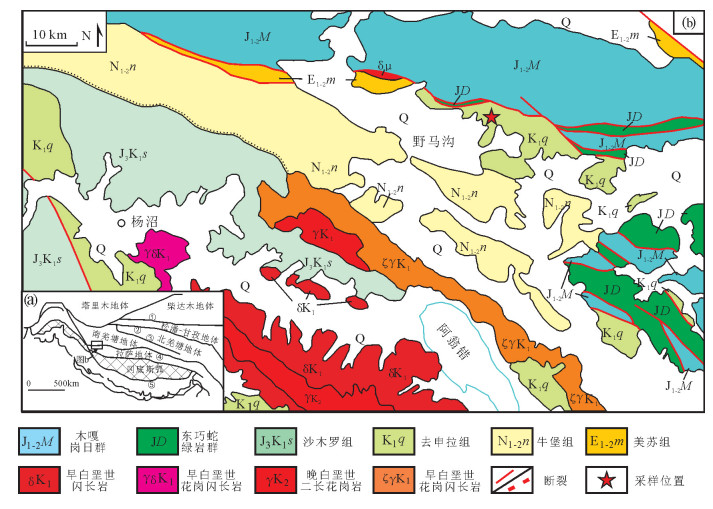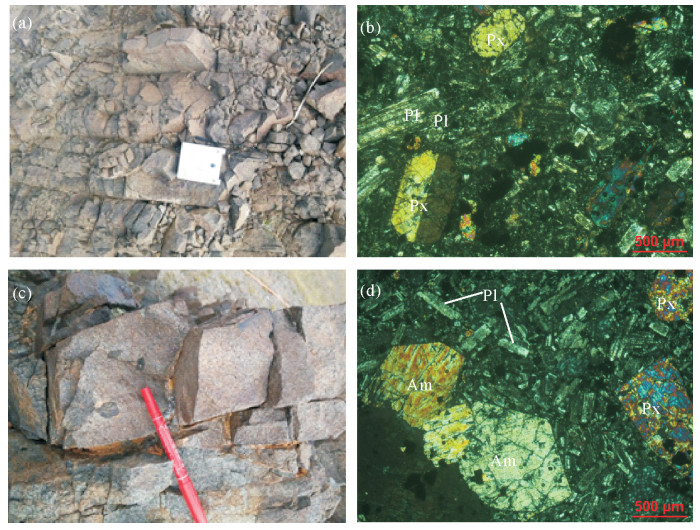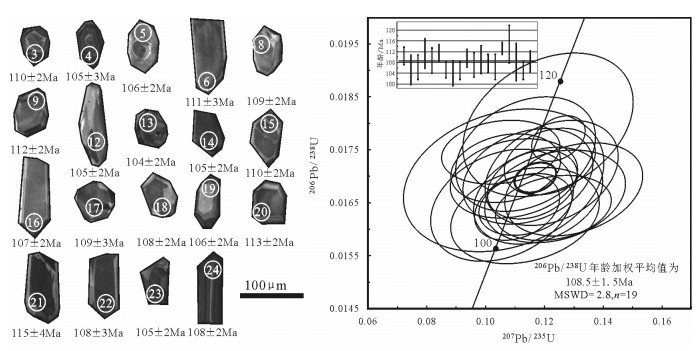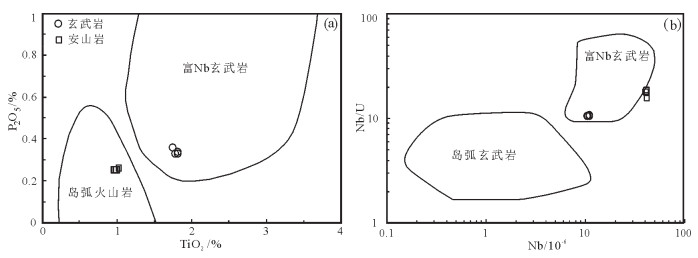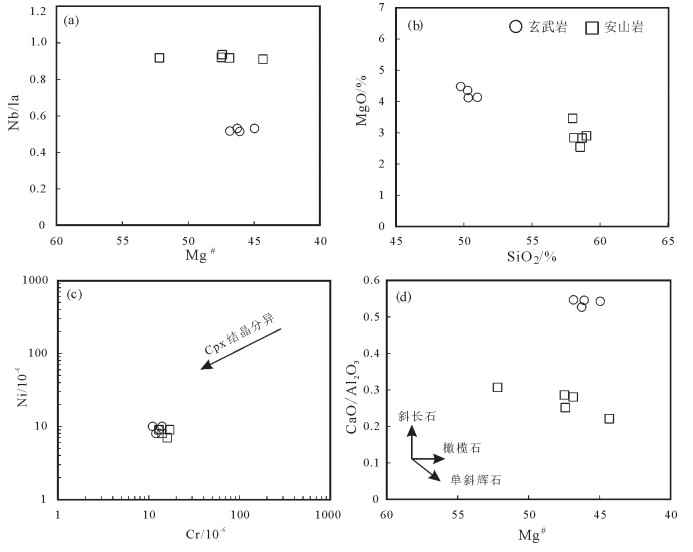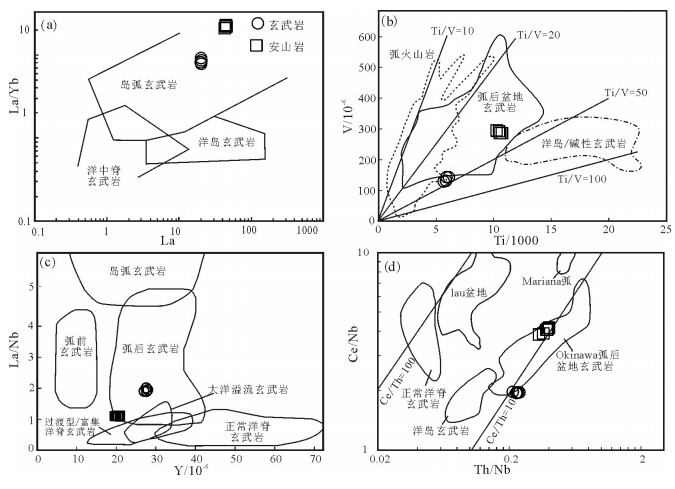The discovery of Nb-rich volcanic rock of the Qushenla Formation in Yema area of the western segment of Bangong Co-Nujiang suture in Tibet and its implications
-
摘要:
以班公湖-怒江缝合带西段的去申拉组玄武岩和安山岩为研究对象,进行了岩石锆石测年和地球化学研究。测年结果显示,安山岩形成于108.5±1.5Ma,属于早白垩世晚期。岩石地球化学特征表明,野马去申拉组玄武岩Nb含量为10.5×10-6~11.1×10-6,Al2O3含量为17.63%~17.96%(平均值17.74%),属于富Nb高铝玄武岩,为中钾钙碱性系列;安山岩属于高钾钙碱性系列岩石。野马火山岩轻、重稀土元素分异明显,其中玄武岩稀土元素总量为119.20×10-6~120.49×10-6,(La/Yb)N值为5.17~5.53;安山岩稀土元素总量为179.97×10-6~184.75×10-6,(La/Yb)N值为13.83~15.12;二者在微量元素上表现出不同程度的富集轻稀土元素和大离子亲石元素,Nb、Ta、Ti等高场强元素相对亏损,具低Cr、Ni,高Sr、Nb、Zr含量,发育岛弧火山岩相关特征。其岩浆源区受俯冲流体的影响较大,后经历了不同程度的铁镁矿物的结晶分离作用。综合分析认为,野马去申拉组火山岩可能形成于弧后盆地构造环境下,是班公湖-怒江特提斯洋岩石圈南向俯冲过程中板片断离导致软流圈地幔上涌,诱发弧后拉张背景下的直接岩浆响应。
Abstract:The volcanic rocks from Qushenla Formation in Yema area is located in the west segment of Bangong Co-Nujiang suture zone, in reverse fault contact with the diabase slice of Bangong Co-Nujiang opiolite melange belt in the north. In this paper, detailed LA-ICP-MS zircon U-Pb dating geochronological and element geochemical studies were carried out for the basalt and andesite in the Qushenla Formation. The U-Pb dating of zircon from andesite yielded a weighted average age of 108.5±1.5Ma, indicating that the andesites were formed at the middle-late stages of Early Cretaceous. Lithogeochemical characteristics show that the Nb-rich basalts in Yema area are characterized by obvious enrichment of Nb and Al2O3, with the values of Nb being 10.5×10-6~11.1×10-6 and Al2O3 being 17.63%~17.96%, averaging 17.74%, suggesting Nb-rich, high-alumina basalt of calc alkaline series. The andesites belong to high-K calc alkaline series. All the volcanic rocks in Yama area are characterized by enriched LREE and relatively depleted HREE. The total REE of basalts are 119.20×10-6~120.49×10-6, with (La/Yb)N from 5.17 to 5.53, and the ∑REE of andesites are 179.97×10-6~184.75×10-6 and their (La/Yb)N range from 13.83 to 15.12. On primitive mantle-normalized trace element diagrams, the basalts and andesite display different degrees of enrichment of LIFEs (e.g., Rb, U, K), relative depletion of HFSE (Nb, Ta, Ti) with high content of Sr, Nb, Zr but low content of Cr, Ni, similar to features of island arc rocks. The magma source region was mainly influenced by the subduction fluid and underwent different degrees of fractionation crystallization of femic minerals with uplifting. A comprehensive study shows that the basalt and andesite of Qushenla Formation in Yema area were probably formed in the backarc tectonic rocks, which might have been the direct magma response to slab break-off caused by asthenosphere upwelling back-arcextension during the southward subduction of Bangong Co-Nujiang Tethyan Ocean at the late stage of Early Cretaceous.
-
Keywords:
- Nb-rich basalt /
- andesite /
- back-arc basin /
- Qushenla Formation /
- Bangong Co-Nujiang suture zone
-
广西南丹大厂是世界级的特大型锡多金属矿田,是中国第二大产锡基地,位于江南古陆西南缘、右江盆地的北东侧。前人对大厂锡多金属矿田矿床成因、成矿时代、稀散元素等开展了大量研究工作[1-5]。对于大厂锡多金属矿田的矿床成因,依然存在争议,争论的焦点主要集中在它们是泥盆系与海底火山作用有关的同生矿床,还是燕山期与笼箱盖花岗岩相关的岩浆热液矿床。陈毓川等[1]、蔡明海等[2]认为大厂矿田形成于燕山期,属于岩浆热液充填-交代型矿床,与笼箱盖花岗岩有关;秦德先等[3]、Yan等[4]则认为该矿床属于同生热水喷流沉积型或与海底火山喷发有关的矿床,矿床形成于泥盆纪,成矿与花岗岩无关;邵主助等[5]通过总结前人的研究结果,认为大厂锡矿床形成于燕山期,属后生充填-交代矿床,与龙箱盖花岗岩有关。
大厂笼箱盖岩体的侵位期次、与成矿的关系、构造环境背景等受到了地质学家的高度关注,其成岩年代学的研究自然成为了众多学者的研究重心。前人尝试用各种方法测试笼箱盖岩体的成岩年龄,李华芹等[6]利用原位SHRIMP U-Pb法和全岩Rb-Sr等时线法测得笼箱盖含斑黑云母花岗岩锆石年龄分别为94±4 Ma和98.6±1.9 Ma;梁婷等[7]利用LA-MC-ICP-MS锆石U-Pb原位定年方法,测得笼箱盖复式岩体中单颗粒锆石的206Pb/238U年龄为103.8~102 Ma、96.6~93.86 Ma、90.1~85.1 Ma;陈毓川等[1]测得笼箱盖复式岩体中细粒黑云母花岗岩的全岩年龄为138.6 Ma,黑云母花岗岩全岩年龄为140 Ma。但积累的年代学数据依然不够,热年代学手段较单一,运用裂变径迹年代学的研究内容鲜有报道,无法对该区构造-热事件年代学进行良好的约束,在一定程度上制约了区域构造-热事件对矿床成因影响的科学理解。
裂变径迹年代学作为国际前缘年代学技术,以其研究载体矿物(锆石、磷灰石等)在重塑地壳上部几千米内数百万年以来的热历史方面显示出巨大优势[8-14]。裂变径迹技术能够记录构造-热时间的年龄,反演构造-热事件,在过去三十多年里,已经被广泛应用于许多火成岩、变质岩和沉积岩[15-16]。无论国内还是国外都已经开展了许多相关的应用研究[11-14, 17-22]。锆石裂变径迹是解决成岩成矿年龄、岩体热历史反演、构造区热事件演化及上升速度等多个领域的可靠且有效手段。本文通过裂变轨迹反演大厂地区构造-热事件演化史,建立该区构造-热演化事件的时间格架,从区域上约束热事件演化过程与构造演化机理,认识构造演化的地球动力学背景,为解决大厂地区矿床成因等科学问题提供新证据,为指导深部及外围找矿提供理论支撑。
本文对大厂矿田笼箱盖岩体的锆石裂变径迹年龄开展研究,通过对其黑云母花岗岩进行年龄厘定,获得了3组新的锆石裂变径迹年龄数据。划分了该岩体的侵入期次,约束构造-热演化过程,为进一步探讨矿区侵入岩与成矿关系、成矿动力学背景、矿床成因等提供新的可靠依据,也为揭示大厂多金属矿田地区的深部地质过程、指导进一步找矿提供新的佐证。
1. 区域地质背景
丹池成矿带处于江南古陆西南缘、右江盆地东北部,是中国重要的有色金属成矿带[23-25],北起芒场、大厂,往南延伸至芙蓉厂、九圩一带,呈NW向带状分布,长约100 km,宽约30 km,受EW向基底断裂与NW向丹池深大断裂控制。西矿带位于大厂褶断带,主要由NW向大厂背斜和大厂断裂组成。该褶断带控制着长坡-铜坑、巴力、龙头山锡石-硫化物矿床[1-2, 25]。区域构造活动强烈,持续时间长,造成区内褶皱构造形态极复杂,但总体构造线仍以NW—SE向为主,其次为EW向、SN向,其他方向的褶皱仅在局部见到,规模小、形态幅度也小。与褶皱构造一样,丹池成矿带断裂构造非常发育,形态分布、活动特征复杂,按构造线展布方向可以分为NW—SE向、NE—SW向、EW向和SN向,其特点均以陡倾断层为主。
区内晚古生代及中生代地层发育,尤以泥盆纪地层独具特色。丹池成矿带上锡多金属矿赋矿层位主要为泥盆系,石炭系、二叠系中仅见到极贫的晚期(后生)方解石石英脉含铜、铅锌等矿化,均不形成工业规模。泥盆系岩性组成自下而上为:中泥盆统纳标组(D2nb)黑色泥岩、页岩和礁灰岩,中泥盆统罗富组(D2lf)粉砂岩、泥岩夹泥质灰岩;该层主要分布于大厂矿田中矿带、西矿带、北香地区,龙头山特富矿体即赋存于该层。上泥盆统榴江组(D3lj)和五指山组(D3w)为硅质岩、条带灰岩及扁豆灰岩,泥灰岩夹钙质页岩、砂岩、炭质页岩等;该层分布于丹池背斜两翼,在大厂矿田内主要分布于大厂背斜两翼及宽洞向斜的冀部,也是丹池成矿带上的主要赋矿层位。
丹池成矿带岩浆活动较强烈,主要为燕山中、晚期的花岗质岩浆活动,表现为中酸性岩浆的侵入,形成黑云母花岗岩、花岗斑岩、石英闪长玢岩、石英斑岩、英安斑岩、白岗岩和少量辉绿玢岩等。岩浆活动集中表现在区内的隆起区段,在非隆起区段目前还没有发现岩浆岩,具体表现为NW向褶断带与矿带内的近SN向的断块隆起带交汇部,沿隆起带边部SN向基底断裂侵位。岩浆岩主要以隐伏岩体形式产出,在地表出露有限,仅见断续出现的岩脉及隐伏岩体顶部的少量岩枝、岩墙等,在芒场、大厂部分地区有岩脉出露,其深部均有花岗岩枝。五圩、北香等隆起区段地表虽无岩浆岩出露,但地质和物探资料显示其深部有花岗岩体的存在。
丹池带上的矿化分带性多局限于“上锡、下铜、中间锌”,“近铜、远锡”的认识,从区域上看,东西方向上以NW向丹池背斜为中心,往东西两侧背斜冀部、南北方向上以大厂矿田为中心,可以简单划分为3个带(隆起区内除外):中心Ⅰ带为Sn-Zn-Pb-Sb-Bn组合,其中以Sn、Zn为主,富黄铁矿、铁闪锌矿,地层中富Ba;往外Ⅱ带为Zn-Pb-Sb组合,以Zn、Cu、Pb、Sb为主,也含Sn、Cu、Ag,富集磁黄铁矿、铅矿物;Ⅲ带为Pb-Sb-Ag-Hg-Sn-Zn组合,金属含量较低。
2. 矿区地质背景
大厂锡多金属矿集区位于华南板块内扬子陆块与南华活动带之间过渡带中的江南地块西南区,丹池大断裂从该矿田东部穿越[1-2, 25]。丹池构造带中的隆起区是丹池成矿带上最重要的构造区段,大厂矿田就是丹池带上最典型的隆起区(图 1)。
![]() 图 1 大厂矿区综合地质图[26]Figure 1. The location oftailings storage in the Dachang mine
图 1 大厂矿区综合地质图[26]Figure 1. The location oftailings storage in the Dachang mine大厂锡多金属矿田褶皱、断裂构造比较复杂(图 1)。矿田内发育一系列NW向褶断带和NE向断裂带,两者交汇部位有利于岩浆热液活动和矿液的聚集。矿体沿NW向构造分布,根据成矿构造的不同特点及矿床产生部位,以及矿化的特点可将矿田分为西、中、东3个构造成矿带。西带由NW走向大厂倒转背斜和NW向、NE向断裂组成,NW向延长8~10 km,断裂带控制宽800~1000 m;中带由丹池断裂和丹池背斜组成,NW向延长15 km,断裂构造控制宽500~800 m,NW向和NE向构造交汇地段有斑状黑云母花岗岩和等粒黑云母花岗岩侵入;东带以NW向断裂为主,走向长8~10 km,断裂控制宽600~900 m。大厂矿田NW向构造和NE向构造的交汇发育,构成大厂矿田构造的基本骨架,控制矿床和矿化区的产出位置,形成矿田矿化分布的基本模式。
大厂锡多金属矿田主要出露泥盆纪、石炭纪和二叠纪硅质岩和碳酸盐建造,其中上泥盆统榴江组和五指山组是大厂锡矿主要的赋矿层位(图 1)。在大厂矿田内部,下泥盆统出露较少,多在背斜核部呈隐伏状,东矿带则出露较好。中泥盆统主要分布于大厂矿田中矿带、西矿带,北香地区地表也有大面积出露,岩性变化及厚度差异均较大,其上部为含生物结晶灰岩、泥灰岩、页岩,下部为生物礁灰岩,深灰色条带状结晶灰岩和结晶生物灰岩,礁灰岩变化极大,龙头山礁灰岩基底为生物屑泥灰岩,盖层为黑色泥页岩、泥灰岩,龙头山特富矿体即赋存于该层。上泥盆统分布于丹池背斜两翼,在大厂矿田内主要分布于大厂背斜两翼及宽洞向斜的冀部,其岩性为硅质岩、条带灰岩及扁豆灰岩,泥灰岩夹钙质页岩、砂岩、炭质页岩等,也是丹池成矿带上的主要赋矿层位。
大厂锡多金属矿田的岩浆活动以中-酸性侵入岩为主,出露面积小,主要分布在矿田中部的笼箱盖复式岩体和笼箱盖及铜坑-长坡-巴里-龙头山-高峰矿区的东西两侧[27]。岩石类型主要有黑云母花岗岩、斑状黑云母花岗岩、花岗斑岩、(石英)闪长玢岩、英安玢岩、白岗岩、石英斑岩等。黑云母花岗岩见于大厂矿田拉么笼箱盖、芒场大山等地,呈隐伏岩株状产出。花岗斑岩呈岩脉状,见于大厂长坡和芒场大山,空间位置上产出于隐伏的黑云母花岗岩上方,最典型的笼箱盖和铜坑-长坡-巴力-龙头山2条花岗斑岩脉均沿SN向断层侵位于泥盆纪—石炭纪地层中,在地表断续出露。石英闪长玢岩和英安玢岩分布于大厂矿田西矿带东侧,呈岩墙状,近SN向分布,倾向E,倾角约70°,岩性变化较大。明显受SN向断裂控制。白岗岩和石英斑岩分布于笼箱盖隐伏的黑云母花岗岩岩株边部,沿断裂和层间断裂充填形成岩株、岩床或岩枝,规模较小。
大厂矿田内矿化分带主要表现在其矿化类型、矿体形态、元素组合和矿石矿物组合呈现有规律的带状分布。矿田内由笼箱盖岩体向外,其矿化类型和成矿元素组合呈现出带状分布的特点。矿田中带发育有受岩体控制的矽卡岩型锌铜锡矿化及叠加其上的晚期SN向钨锑矿带(以拉么、茶山为代表);岩体外围东西两侧,受NW向构造和地层的控制,形成了NW向大福楼-坑马和EW向长坡-雷打石(以长坡、铜坑、龙头山为代表)2条锡多金属矿带。按矿化金属元素组合,大厂矿田具有如下4种元素组合类型:Zn-Cu型(拉么);W-Sn-Pb型(茶山);Sn-Zn-Pb-Sb型(西矿带的长坡、铜坑、龙头山);Sn-Zn型(东矿带大福楼、坑马)。大厂矿田及外围具有较明显的垂直分带特征, 代表性矿床有长坡矿区和大福楼矿区,均具有上部为脉状、细脉状、网脉状的锡金属矿体,下部为顺层分布的层状、似层状锡多金属矿体。
3. 岩体特征及样品描述
笼箱盖岩体是位于大厂锡多金属矿田中部的笼箱盖地区规模最大的侵入体。地处NW向丹池褶断带与NE向断裂构造的交汇处,侵位于泥盆系碳酸盐岩-碎屑岩建造中,岩体的分布走向与主构造线方向一致[28]。该岩体地表出露较少,仅见含斑黑云母花岗岩呈近SN向的脉状和岩枝状产出,主体以隐伏岩体形式出现[1]。
笼箱盖岩体地表为SN走向的陡倾黑云母花岗斑岩脉,深部为呈三角形展布的岩株。根据钻孔和重力资料,岩体向深部呈巨大的岩基,呈上小下大的锥状,且西陡东缓,向下一直延伸到铜坑-长坡矿床的深部,已有钻孔控制的面积约为21 km2[2]。本次研究样品(LXG-01、LXG-03、LXG-04)均采自笼箱盖岩体的黑云母花岗岩,采样位置如图 1。黑云母花岗岩呈灰白色,花岗结构,块状构造,主要矿物成分为石英、钾长石、斜长石、黑云母,副矿物有锆石、磷灰石、钛铁矿、黄玉、电气石等,发育少量长石斑晶。
石英呈半自形-他形产出(图版Ⅰ-a),晶粒大小悬殊,多数为0.2~0.5 mm,内部裂隙发育,常被黑云母、斜长石、钾长石交代呈港湾状(图版Ⅰ-e、g、i),局部颗粒内部被斜长石交代呈圆形孔洞(图版Ⅰ-f)。斜长石呈浑圆状,泥化严重,常呈不规则状、星点状分布于钾长石上,具卡式双晶,颗粒大小主体为0.4~0.6 mm,常交代黑云母与石英,呈港湾状(图版Ⅰ-a、b、e、i)。钾长石交代残余呈条纹状,表面带脏感,颗粒大小较大,0.6~0.8 mm裂隙发育,泥化的钾长石呈卡斯巴双晶(图版Ⅰ-c),交代石英呈港湾状(图版Ⅰ-h)。黑云母正交光下呈紫色、绿色、黄色等,颗粒不规则分布(图版Ⅰ-d),含量较少,节理明显,常被斜长石、钾长石交代呈港湾状,同时自身也交代石英(图版Ⅰ-e)。
4. 裂变径迹分析方法
样品经过粉碎后,采用标准的磁选和重液分离技术,从破碎的岩石样品中提取磷灰石和锆石颗粒。样品粉碎至颗粒尺寸与岩石中矿物的大小相适应,通常约为60目;利用传统方法粗分离后,采用常规破碎、磁选、重液分离等技术对样品进行分离。锆石和磷灰石的处理方法有所不同。锆石颗粒均匀撒在载玻片上,用1.6 cm×1.6 cm的Teflon片轻轻盖在颗粒上,然后置于加热台上加热的同时垂直用力摁压,直至锆石镶嵌在PFA Teflon片中;第二个步骤为抛光,砂纸依次为500#、1200#、2400#,金刚砂依次6 μm、3 μm、1 μm,垂直用力,边磨边旋转,直至揭出锆石的最大面;使用摩尔比值为NaOH/KOH(=1:1)共溶混合物蚀刻样品,时间为25 h,加热台温度为210 ℃;然后采用无铀云母片与样品叠加,胶带固定三角扎孔定位,样品、标样(FCT)、标准玻璃(CN5)按照顺序置于辐射罐中,通量一般选择1.2×1015 cm-2·s-1;最后是云母蚀刻,分离云母和样品靶,在40%HF中蚀刻云母20 min取出后洗干净,保证样品靶不要弯曲,进入样品统计。
裂变径迹中心年龄[29]采用IUGS推荐的Zeta校准方法计算[30],依据Green提出的方法计算误差[31]。本次实验锆石的Zeta值分别为102.1±3.8,P(χ2)用来评价所测单个粒子属于同一年龄组的概率;当P(χ2)>5%时,裂变径迹样品含有单一年龄群体[32],当P(χ2) < 5%时,表明单颗粒年龄不均匀分布,不服从正态分布,需要使用BinomeFit软件[33]对裂变径迹年龄进行分解。
5. 分析结果
表 1和图 2为3份样品的锆石裂变径迹数据分析结果。研究结果表明,3份锆石样品的χ2检验均不合格(P(χ2) < 5%),表明样本的单一年龄是分散的,属于混合年龄。因此,需要对χ2检验值小于5%的3个不服从正态分布的样品使用二进制软件[33]进行分解裂变径迹年龄,分解结果如图 3所示。
表 1 锆石裂变径迹结果Table 1. Zircon fission track result样号 岩性 颗粒数
/nρs/(105·cm-2)
(Ns)ρi/(105·cm-2)
(Ni)ρd /(105·cm-2)
(Nd)P(χ2)
/%中心年龄
/Ma±1σ池年龄
/Ma±1σLXG-01 黑云母花岗岩 25 141.281(6444) 107.013(4881) 18.062(8055) 0 121±7 121±5 LXG-03 黑云母花岗岩 21 99.661(3566) 96.699(3460) 17.604(8055) 0 91±5 92±4 LXG-04 黑云母花岗岩 16 139.83(3615) 120.025(3103) 17.259(8055) 0 102±6 102 ±5 注:Ns为自发径迹数,Ni为诱发径迹数,Nd为标准铀玻璃的外探测器白云母记录的径迹数;ρs、ρi和ρd分别为与Ns、Ni和Nd相对应的径迹密度;n为径迹的条数,P(χ2)为χ2检验几率,锆石年龄运用ζ(Zeta)=90.9 ±2.8(yrcm2/tr)进行计算 样品LXG-01的锆石裂变径迹的中心年龄为121±7 Ma(表 1;图 2和图 3),24个独立个体年龄在189.55~92.67 Ma之间,通过对其进行二项分解可以得到2个年龄组:106.8 Ma(P1)和151.2 Ma(P2),以106.8 Ma为主导。样品LXG-03的锆石裂变径迹的中心年龄为91±5 Ma(表 1;图 2和图 3),20个独立个体年龄在124.96~63.95 Ma之间,通过对其进行二项分解可以得到2个年龄组:77.2 Ma(P1)和101.7 Ma(P2),以101.7 Ma占主导。样品LXG-04的锆石裂变径迹的中心年龄为102±6 Ma(表 1;图 2和图 3),15个独立个体年龄在140.84 ~78.28 Ma之间,通过对其进行二项分解可以得到2个年龄组:85.2 Ma(P1)和112.3 Ma(P2),以112.3 Ma占主导。
6. 讨论
6.1 岩浆侵入期次及地质意义
多年来,众多研究者对大厂地区的笼箱盖岩体开展了大量的年代学工作。已有研究表明,岩浆岩多期多阶段岩浆活动是岩体形成的主要原因[1, 6-7, 34-35]。研究区经历了多期继承性的岩浆事件,后期岩浆活动及区域性热力作用常带来巨大的热量,早期岩体形成后遭受后期地质作用改造叠加,干扰年龄厘定。裂变径迹热年代学技术属于新兴技术方法,借助该技术开展年代学研究,是当前国际前沿课题[11-14]。裂变径迹年代法能够精确记录成岩后热液活动、构造运动等一系列热事件的年龄。锆石裂变径迹封闭温度为250℃,部分退火温度为200~300℃,拥有较高的封闭温度,对温度的灵敏程度比其他测年方法更敏感,能够准确记录多期次的岩浆热液活动。因此,本文在前人研究的基础上,利用锆石裂变径迹精确厘定笼箱盖岩体黑云母花岗岩的年龄,为岩浆活动期次划分及其与成矿的关系研究提供了有力证据。
本次测得的锆石裂变径迹年龄变化于160~70 Ma之间,这些年龄值由多个细分年龄组构成,分别为160~150 Ma、120~100 Ma和90~70 Ma。从对应的径迹年龄直方图统计明显看出,笼箱盖岩体具有3个阶段热历史,分别记录了3期次的岩浆侵入活动(图 4)。
燕山期以来,整个华南克拉通拉张体制作用下幔源岩浆的大量输入[36-43],前人总结划分了5次岩石圈伸展期的花岗岩侵位事件,即164~153 Ma、146~136 Ma、129~122 Ma、109~101 Ma和97~87 Ma[44]。由于受到环太平洋板块俯冲的影响,侏罗纪经历了由东向西古特提斯构造域向东北太平洋边缘构造域的过渡,前人认为广西全境内发育大规模岩浆活动,燕山期早期(170~140 Ma)和燕山晚期(120~80 Ma)是广西2个重要的岩浆活动时期[28]。
晚侏罗世岩浆侵入活动(160~150 Ma):笼箱盖复式岩体位于桂西北大厂超大型锡多金属矿田中部的笼箱盖地区,是大厂矿田中规模最大的侵入体[6-7, 45-46]。前人测得笼箱盖复式岩体中细粒黑云母花岗岩的全岩年龄为138.6 Ma和黑云母花岗岩全岩年龄为140 Ma[1],均属于燕山中期的年龄。燕山中期由于受到环太平洋板块俯冲影响,整个华南克拉通在拉张体制作用下发生幔源岩浆侵入活动。本次利用锆石裂变径迹定年法厘定了笼箱盖黑云母花岗岩中的早期构造热事件阶段亦属于燕山中期(160~150 Ma);该年龄与燕山中期区域上岩浆热事件吻合,代表早期的岩浆侵入活动。
早白垩世岩浆侵入活动(120~100 Ma):早白垩世(130~110 Ma)整个华南地区出现一次快速岩石圈减薄事件,多阶段的岩石圈伸展-减薄、玄武质岩浆底侵和大规模花岗质岩浆活动,可能是华南内陆地区侏罗纪以来标志性的大陆动力学事件[47]。前人用各种方法测试了笼箱盖复式岩体的成岩年龄。李璞等利用K-Ar法获得等粒状花岗岩全岩年龄为107 Ma[48];徐文忻[49]、蔡宏渊等[34]利用相同的方法测得等粒状黑云母花岗岩年龄为99±6 Ma,斑状黑云母花岗岩年龄115±3 Ma。这与本文120~100 Ma的锆石裂变径迹年龄一致。
晚白垩世岩浆侵入活动(90~70 Ma):晚白垩世(100~80 Ma)桂西北地区在整个华南伸展的构造环境下发育一期较晚的岩浆活动[50-51]。陈毓川等[1]利用K-Ar法测得中细粒黑云母花岗岩的全岩年龄为77.7 Ma,斑状黑云母花岗岩中黑云母年龄为85.39 Ma、钾长石的年龄为88.2 Ma;梁婷等[7]利用LA-MC-ICP-MS锆石U-Pb原位定年方法,获得笼箱盖岩体的晚期年龄区间为90.1~85.1 Ma;这些都是区内此次伸展阶段的产物。本次锆石裂变径迹存在的年龄组90~70 Ma亦为伸展阶段较晚一期的岩浆侵入活动。
6.2 岩浆活动与成矿作用
从大区域看,华南地区晚中生代岩石圈大减薄事件显著[47, 52-57];自西向东由老到新形成了上千千米的酸性岩浆岩带,这些岩石的成因和与壳幔的相互关系可能与太平洋板块向西俯冲有密切关系[47-58]。前人通过对华南燕山期大量的矿物岩石学研究,认为中侏罗世以来华南发生了大范围的岩石圈伸展作用[50, 53, 58-67];岩石圈伸展与壳幔之间发生强烈的相互作用[45-46, 56-57],引发大规模的花岗质岩浆活动[53]。花岗岩浆作用与成矿流体的分异存在不同程度的关系[47],为成矿提供了有利条件。这些构造热事件和火成岩活动在空间和时间上与华南地区广泛的多金属成矿有关。侏罗纪以来,整个华南克拉通构造格局巨大调整、复杂的壳幔相互作用及拉张体制作用下幔源岩浆的大量输入,伴随着成矿大爆发,形成了大量与该岩浆活动有关的高温钨-锡多金属矿床、铜-铁钼多金属矿床、铜-钼-(铅-锌)斑岩型矿床和低锑-金-汞-砷-砣型矿床[36-43, 47]。
燕山晚期华南地区主要发生了2次爆发式成矿期(140~125 Ma和110~80 Ma)[68]。前人对华南一些矿床进行了年代学研究,陈富文等[69]通过U-Pb法获得广西龙头山金矿中矿化流纹斑岩和花岗斑岩的年龄分别为103.3±2.4 Ma、100.3±1.4 Ma[69];李文亢[70]运用Pb-Pb法测定戈塘金矿年龄为100 Ma。前以对于桂西北大厂超大型锡多金属矿田也进行了成矿年龄厘定,李华芹等[6]对拉么锌铜矿床的形成年龄进行了测定,获得锌-铜矿石中石英矿物Rb-Sr等时线年龄为98.6±5.8 Ma;陈毓川等[1]测得大厂矿田伊利石的K-Ar年龄为117.8 Ma和104.8 Ma;苏晓凯[28]总结认为,桂北地区成矿时代主要集中于晚燕山期(120~90 Ma)。前人的测年结果与本文的锆石裂变径迹年龄(120~100 Ma)完全一致,时间上与笼箱盖岩体晚期的岩浆侵入活动时间吻合,反映早白垩世岩浆侵入活动(120~100 Ma)与该区成矿作用存在密切关系。
空间上,大厂多金属矿田以笼箱盖黑云母花岗岩为中心,从接触带向外依次为矽卡岩锌铜矿床→矽卡岩锌矿床→锡石-多金属硫化物矿床→辰砂-方解石矿床(局部含极少量锡石)。锡矿体在黑云母花岗岩附近常被后期的钨、锑矿床叠加穿插,在大福楼深部钻孔及灰东村一带坑道中均可见到锡石-硫化物矿体被白钨矿-萤石脉切穿;在笼箱盖顶可见辉锑矿-石英脉切入黑钨矿-石英脉。可以看出,矿体产出与笼箱盖花岗岩体空间关系非常密切。
大厂地区花岗岩有丰富的成矿元素,并有足够的挥发分使金属元素转移至热流体中,能为成矿提供主要金属和成矿热流体[71-72]。同时,笼箱盖复式岩体内及其附近围岩中均未发现典型的、与岩浆成因直接有关的锡矿化类型,如含锡云英岩、锡石石英脉型、矽卡岩型等,并且矿田内总体蚀变极弱,与其他典型岩浆热液矿床相比差异非常明显。此外,前人通过流体包裹体研究发现,成矿流体除来自花岗岩热流体外,还有地下热水加入[73-74]。由此可见,锡矿床的形成并非完全由岩体控制,如巴力-龙头山矿床等,与岩体关系不密切,大厂花岗岩虽然含锡较高,但并非是良好的成矿花岗岩。
地幔上涌导致的热异常和地壳拉张引起的驱动力对驱动盆地流体大规模运移成矿起着重要的控制作用;其成矿动力学背景为中生代特提斯大洋板块向东俯冲的增生大陆边缘弧后伸展盆地[75-77]。地幔深部上涌的酸性岩浆热液垂直运移,对地层产生应力作用,地层发生变形破碎,形成断裂和层间破碎带,热液不断上涌,提供了大量的岩浆热液,形成大量富含S2-、S-、Cl-等的地质流体,同时流体在运移过程中从岩体中萃取Sn2+、Zn2+、Cu2+等成矿元素[78]。随着岩体的侵入,这些携带大量成矿物质的热液沿断裂充填,形成高角度脉状矿体,同时含矿热液向两侧地层交代,形成似层状矿体,从而形成矿床。
由此可见,大厂矿田地层沉积过程中,受海底和热液作用影响,矿质有初始富集作用,燕山晚期的黑云母花岗岩在笼箱盖地区侵入和燕山期(120~100 Ma)的构造作用使矿化富集形成大型-特大型矿床。笼箱盖岩体的控矿作用主要表现在为成矿提供部分含锡多金属及对活化迁移成矿元素有利的挥发性气体的初始热流体,更重要的是,为早期矿化的下部地层中成矿物质迁移、富集提供了强大的热能和必要的物理化学条件。也就是说,大厂矿田花岗岩活动为矿田内外的二次成矿作用提供物源和富集条件、迁移热动能及沉淀成矿条件。
7. 结论
(1) 笼箱盖岩体的锆石裂变径迹年龄变化于160~70 Ma之间,这些年龄值由多个细分年龄组构成,分别为160~150 Ma、120~100 Ma和90~70 Ma,具有明显的3个阶段热历史,记录了3期岩浆侵入活动。
(2) 大厂多金属矿田的成矿时代与笼箱盖岩体早白垩世岩浆侵入活动(120~100 Ma)吻合,该区成岩成矿与燕山期环太平洋板块俯冲影响下的岩石圈伸展期的花岗岩侵位事件相关;岩浆侵入活动不仅为成矿提供部分含锡多金属及对活化迁移成矿元素有利的挥发性气体的初始热流体,还为早期矿化的下部地层中成矿物质迁移、富集提供强大的热能和必要的物理化学条件。
致谢: 感谢野外工作过程中四川地调院西藏昂龙岗日1:5万区域地质调查项目组其他成员的热心帮助;感谢审稿专家提出的宝贵修改意见和建议。 -
图 6 去申拉组火山岩稀土元素球粒陨石标准化配分图(a)和微量元素原始地幔标准化蛛网图(b)
(标准化数据据参考文献[21])
Figure 6. Chondrite-normalized REE patterns (a) of primitive mantle-normalized trace element patterns (b) for volcanic rocks of Qushenla Formation
表 1 野马去申拉组安山岩LA-ICP-MS锆石Th-U-Pb分析结果
Table 1 LA-ICP-MS zircon U-Th-Pb analytical results of andesite from Qushenla Formation, Yema area
测点号 元素含量/10-6 238U/232Th 207Pb/206Pb 207Pb/235U 206Pb/238U 207Pb/206Pb 207Pb/235U 206Pb/238U PbTotal 232Th 238U 比值 比值 ±1σ 比值 ±1σ 比值 ±1σ 年龄/Ma ±1σ 年龄/Ma ±1σ 年龄/Ma ±1σ PM4N1-03 16.9 1404 557 0.42 0.0512 0.0027 0.1218 0.0063 0.0173 0.0003 250 124 117 6 110 2 PM4N1-04 2.91 160 116 0.76 0.0475 0.0054 0.1056 0.0099 0.0165 0.0004 72 248 102 9 105 3 PM4N1-05 5.21 318 209 0.69 0.0549 0.0048 0.1236 0.0098 0.0166 0.0004 409 192 118 9 106 2 PM4N1-06 3.30 174 136 0.83 0.0502 0.0050 0.1136 0.0097 0.0174 0.0004 211 206 109 9 111 3 PM4N1-08 4.74 291 186 0.68 0.0491 0.0041 0.1144 0.0090 0.0170 0.0004 154 185 110 8 109 2 PM4N1-09 8.60 617 299 0.51 0.0440 0.0036 0.1051 0.0082 0.0175 0.0002 174 159 102 8 112 2 PM4N1-12 20.0 1892 601 0.33 0.0498 0.0029 0.1136 0.0065 0.0165 0.0002 183 139 109 6 105 2 PM4N1-13 3.56 176 151 0.90 0.0516 0.0053 0.1134 0.0103 0.0163 0.0004 333 237 109 9 104 2 PM4N1-14 14.6 1133 508 0.47 0.0487 0.0027 0.1107 0.0059 0.0164 0.0003 132 130 107 5 105 2 PM4N1-15 8.72 566 315 0.62 0.0465 0.0037 0.1068 0.0076 0.0172 0.0003 33 172 103 7 110 2 PM4N1-16 5.66 329 228 0.73 0.0560 0.0044 0.1300 0.0096 0.0168 0.0004 454 144 124 9 107 2 PM4N1-17 4.18 254 156 0.65 0.0537 0.0051 0.1224 0.0092 0.0171 0.0004 361 215 117 8 109 3 PM4N1-18 19.7 1620 610 0.42 0.0500 0.0027 0.1159 0.0062 0.0168 0.0003 195 131 111 6 108 2 PM4N1-19 5.23 282 206 0.78 0.0535 0.0047 0.1179 0.0090 0.0166 0.0004 350 169 113 8 106 2 PM4N1-20 103 10565 2471 0.25 0.0506 0.0015 0.1248 0.0037 0.0177 0.0002 233 67 119 3 113 1 PM4N1-21 2.15 104 85.7 0.86 0.0537 0.0064 0.1212 0.0118 0.0180 0.0006 361 264 116 11 115 4 PM4N1-22 2.17 115 85.8 0.78 0.0491 0.0072 0.1061 0.0139 0.0169 0.0006 154 311 102 13 108 3 PM4N1-23 11.56 882 413 0.51 0.0544 0.0038 0.1230 0.0080 0.0164 0.0003 387 159 118 7 105 2 PM4N1-24 6.79 451 261 0.60 0.0470 0.0039 0.1096 0.0088 0.0170 0.0003 50 189 106 8 108 2 表 2 野马玄武岩和安山岩主量、微量和稀土元素组成
Table 2 Major elements, trace elements and REE composition of the basalt and andesite, Yema area
岩性 玄武岩 安山岩 样号 PM4ZH1 PM4ZH2 PM4ZH3 PM4ZH4 PM4ZH5 PM4ZH6 PM4ZH7 PM4ZH8 PM4ZH9 Al2O3 17.96 17.66 17.72 17.63 18.34 17.2 17.05 17.08 17.06 BaO 0.05 0.04 0.03 0.03 0.07 0.06 0.07 0.07 0.08 CaO 9.82 9.3 9.67 9.57 4.05 4.92 4.78 5.24 4.29 TFe2O3 10.07 9.5 10.08 9.99 6.32 6.2 6.38 6.28 6.37 K2O 0.91 1.11 1.21 0.84 2.68 2.42 2.74 2.28 2.7 MgO 4.48 4.13 4.35 4.12 2.54 2.83 2.84 3.46 2.9 MnO 0.16 0.17 0.21 0.2 0.14 0.15 0.16 0.2 0.17 Na2O 3.37 3.58 3.25 3.53 5.59 4.81 4.85 4.48 5.24 P2O5 0.34 0.36 0.33 0.33 0.25 0.25 0.26 0.26 0.25 SiO2 49.76 50.99 50.27 50.32 58.55 58.69 58.09 57.99 59.01 TiO2 1.82 1.75 1.82 1.78 0.98 0.97 1.02 1.02 1 FeO 2.77 2.61 2.99 2.8 1.74 2.25 2.19 2.3 2.14 烧失量 1.4 1.33 1.02 1.31 1.1 1.6 1.65 1.47 1.46 总计 100.14 99.92 99.96 99.65 100.61 100.1 99.89 99.83 100.53 Rb 14.7 18.9 26.6 15.7 72.3 68.1 84.4 65.1 79.9 K 1310 1100 1600 1650 1470 1460 1650 1020 1371.111 Ba 361 339 280 292 646 562 649 583 741 Th 3.96 4.02 3.93 3.92 9.62 9.59 9.31 9.47 9.02 U 1.01 1.04 0.98 1.02 2.21 2.28 2.25 2.63 2.31 Nb 10.7 11.1 10.5 11 41.9 41.7 41 41.6 40.9 Sr 604 638 568 620 631 628 676 687 708 Nd 23.3 23.5 23.3 23 27.8 27.2 27.9 28 27.6 P 1450 1510 1470 1460 1100 1080 1120 1110 1070 Zr 139 143 139 139 247 246 241 243 240 Hf 3.9 3.9 3.8 3.7 6 5.8 5.6 5.8 5.5 Sm 5.58 5.71 5.73 5.58 5.18 4.94 5.1 5 5.03 Ti 10600 10300 10700 10500 5900 5800 6100 6000 5800 Ta 0.7 0.7 0.7 0.7 2.6 2.6 2.6 2.5 2.4 La 20.7 20.9 20.4 20.7 46 45.3 44.7 45.3 43.7 Ce 43.3 43.7 43.2 43.3 81.1 80.7 78.9 80.3 79.4 Pr 5.65 5.7 5.7 5.66 8.59 8.43 8.47 8.53 8.41 Nd 23.3 23.5 23.3 23 27.8 27.2 27.9 28 27.6 Sm 5.58 5.71 5.73 5.58 5.18 4.94 5.1 5 5.03 Eu 1.8 1.85 1.81 1.88 1.56 1.51 1.51 1.49 1.54 Gd 5.85 5.8 5.91 5.75 4.27 4.1 4.2 4.24 4.39 Tb 0.91 0.89 0.92 0.86 0.67 0.62 0.63 0.64 0.64 Dy 5.31 5.23 5.34 5.2 3.84 3.6 3.67 3.65 3.73 Ho 1.03 1.06 1.04 1.04 0.73 0.68 0.71 0.7 0.72 Er 2.9 2.82 2.91 2.85 2.23 2.02 2.17 2.07 2.07 Tm 0.4 0.41 0.41 0.41 0.31 0.29 0.3 0.3 0.3 Yb 2.7 2.55 2.56 2.61 2.15 2.02 2.08 2.02 2.13 Lu 0.37 0.37 0.38 0.36 0.32 0.3 0.31 0.31 0.31 U 1.01 1.04 0.98 1.02 2.21 2.28 2.25 2.63 2.31 注:主量元素含量单位为%,微量和稀土元素为10-6 -
潘桂堂, 莫宣学, 侯增谦, 等.冈底斯造山带的时空结构及演化[J].岩石学报, 2006, 22(3):521-533. http://d.old.wanfangdata.com.cn/Periodical/ysxb98200603001 耿全如, 潘桂堂, 王立全, 等.班公湖-怒江、羌塘地块特提斯演化与成矿地质背景[J].地质通报, 2011, 30(8):1261-1274. http://dzhtb.cgs.cn/gbc/ch/reader/view_abstract.aspx?file_no=20110813&flag=1 朱弟成, 潘桂堂, 莫宣学, 等.冈底斯中北部晚侏罗世-早白垩世地球动力学环境:火山岩约束[J].岩石学报, 2006, 22(3):534-546. http://d.old.wanfangdata.com.cn/Periodical/ysxb98200603002 朱弟成, 莫宣学, 赵志丹, 等.西藏冈底斯带措勤地区则弄群火山岩锆石U-Pb年代学格架及构造意义[J].岩石学报, 2008, 24(3):401-412. http://d.old.wanfangdata.com.cn/Periodical/ysxb98200803001 李金祥, 李光明, 秦克章, 等.班公湖带多不杂富金斑岩铜矿床斑岩-火山岩的地球化学特征与时代:对成矿构造背景的制约[J].岩石学报, 2008, 24(3):531-543. http://d.old.wanfangdata.com.cn/Periodical/ysxb98200803013 康志强, 许继峰, 王保弟, 等.拉萨地块北部白垩纪多尼组火山岩的地球化学:形成的构造环境[J].地球科学-中国地质大学学报, 2009, 34(1):89-104. doi: 10.3321/j.issn:1000-2383.2009.01.009 康志强, 许继峰, 王保弟, 等.拉萨地块北部去申拉组火山岩:班公湖-怒江特提斯洋南向俯冲的产物?[J].岩石学报, 2010, 26(10):3106-16. http://d.old.wanfangdata.com.cn/Periodical/ysxb98201010022 Sui Q L, Wang Q, Zhu D C, et al. Compositional diversity of ca. 110Ma magmatism in the northern Lhasa Terrane, Tibet:Implications for the magmatic origin and crustal growth in a continent-continent collision zone[J]. Lithos, 2013, 168:144-159. https://www.researchgate.net/publication/256806817_Compositional_diversity_of_ca_110_Ma_magmatism_in_the_northern_Lhasa_Terrane_Tibet_Implications_for_the_magmatic_origin_and_crustal_growth_in_a_continent-continent_collision_zone
Zhu D C, Li S M, Cawood P A, et al. Assembly of the Lhasa and Qiangtang terranes in central Tibet by divergent double subduction[J]. Lithos, 2015, 245:7-17. http://www.wanfangdata.com.cn/details/detail.do?_type=perio&id=be4c438f22b463f182154e4494786812
Zhang K, Xia B, Wang G, et al. Early Cretaceous stratigraphy, depositional environments, sandstone provenance, and tectonic setting of central Tibet, western China[J]. Geological Society of America Bulletin, 2004, 116(9):1202-1222. doi: 10.1130/B25388.1
Liu Y S, Hu Z C, Cao S, et al. In Situ Analysis of Major and Trace Elments of Anhydrous Minerals by LA-ICP-MS without Applying an Internal Standard[J]. Chemical Geology, 2008, 257(1/2):34-43. http://cn.bing.com/academic/profile?id=f10fa454267bcd9d2c140163950f1005&encoded=0&v=paper_preview&mkt=zh-cn
Hoskin P W, Black L P. Metamorphic zircon formation by solid, state recrystallization of protolith igneous zircon[J]. Journal of Metamorphic Geology, 2000, 18(4):423-439. http://www.wanfangdata.com.cn/details/detail.do?_type=perio&id=20f7cb4f6d72be021ecb081c5fa74229
李伟.西藏改则地区去申拉组火山岩地球化学特征及锆石年代学制约[D].中国地质大学(北京)硕士学位论文, 2012. http://cdmd.cnki.com.cn/Article/CDMD-11415-1012364960.htm 于枫.西藏冈底斯盐湖南部花岗岩的岩石学、地球化学与成因[D].中国地质大学(北京)硕士学位论文, 2012. http://cdmd.cnki.com.cn/article/cdmd-11415-2010085574.htm 马义明.拉萨地块早白垩世火山岩古地磁学和年代学研究对亚洲南缘的古地理限制[D].中国地质大学(北京)硕士学位论文, 2013. http://cdmd.cnki.com.cn/Article/CDMD-11415-1013272977.htm 隋清霖.西藏拉萨地块盐湖地区早白垩世岩浆岩年代学、岩石成因及构造意义[D].中国地质大学(北京)硕士学位论文, 2014. http://cdmd.cnki.com.cn/Article/CDMD-11415-1014239465.htm Wilson M. Igneous Petrogenesis[M]. London:Unwin Hyman, 1989:101-149.
Winchester J A, Floyd P A. Geochemical discrimination of different magma series and their differentiation products using immobile elements[J]. Chemical Geology, 1977, 20:325-343. doi: 10.1016/0009-2541(77)90057-2
Peccerillo A, Taylor S R. Geochemistry of Eocene calc-alkaline volcanic rocks from the Kastamonu area, northern Turkey[J]. Contributions to Mineralogy and Petrology, 1976, 58(1):63-81. doi: 10.1007/BF00384745
Streckeisen A, Bonin B, Le Bas M J, et al. Igneous Rocks:a classification and glossary of terms[M]. Oxford:Cambridge University Press, 2005:1-256.
Sun S S, McDonough W F. Chemical and isotopic systematics of oceanic basalts:implications for mantle composition and processes[J]. Geological Society, London, Special Publications, 1989, 42(1):313-345. doi: 10.1144/GSL.SP.1989.042.01.19
Crawford A J, Falloon T J, Eggins S. The origin of island arc high alumina basalts[J]. Contributions to Mineralogy and Petrology, 1987, 97:417-430. doi: 10.1007/BF00372004
徐夕生, 邱检生.火成岩岩石学[M].北京:科学出版社, 2010:1-346. Sajona F G, Maury R C, Bellon H, et al. Initiation of subduction and the generation of slab melt in western and eastern Mindanao Philippines[J]. Geology, 1993, 21(11):1007-1010. doi: 10.1130/0091-7613(1993)021<1007:IOSATG>2.3.CO;2
Sajona F G, Maury R C, Bellon H, et al. High field strength element enrichment of Pliocene-Pleistocene island arc basalts, Zamrboanga Peninsula, western Mindanao (Philippines)[J]. Journal of Petrology, 1996, 37(3):693-726. doi: 10.1093/petrology/37.3.693
Zhang H R, Yang T N, Hou Z Q, et al. Evonian Nb-enriched basalts and andesites of north-central Tibet:Evidence for the early subduction of the Paleo-Tethyan oceanic crust beneath the North Qiangtang Block[J]. Tectonophysics, 2016, 682:96-107. doi: 10.1016/j.tecto.2016.06.009
Mao Q G, Xiao W J, Fang T H, et al. Late Ordovician to early Devonian adakites and Nb-enriched basalts in the Liuyuan area, Beishan, NW China:Implications for early Paleozoic slab-melting and crustal growth in the southern Altaids[J]. Gondwana Research, 2012, 22:534-553. doi: 10.1016/j.gr.2011.06.006
Wang Q, Wyman D A, Zhao Z H, et al. Petrogenesis of Carboniferous adakites and Nb-enriched arc basalts in the Alataw area, northern Tianshan Range (western China):Implications for Phanerozoic crustal growth in the Central Asia orogenic belt[J]. Chemical Geology, 2007, 236:42-64. doi: 10.1016/j.chemgeo.2006.08.013
李永军, 沈锐, 王冉, 等.新疆西准噶尔巴尔努克早石炭世富Nb岛弧玄武岩的发现及其地质意义[J].岩石学报, 2014, 30(12):3501-3511. http://d.old.wanfangdata.com.cn/Periodical/ysxb98201412002 Defant M J, Xu J F, Kepezhinskas P. Adakite:some variations on a theme[J]. Acta Petrologica Sinica, 2002, 18:129-142. http://d.old.wanfangdata.com.cn/Periodical/ysxb98201002023
Kepezhinskas P K, Defant M J, Drummond M S. Progressive enrichment of island arc mantle by melt-peridotite interaction inferred from Kamchatka xenoliths[J]. Geochimica et Cosmochimica Acta, 1996, 60:1217-1229. doi: 10.1016/0016-7037(96)00001-4
Rogers R D, Kárason H, Van der Hilst R D. Epeirogenic uplift above a detached slab in northern Central America[J]. Geology, 2002, 30(11):1031-1034. doi: 10.1130/0091-7613(2002)030<1031:EUAADS>2.0.CO;2
Lassiter J C, DePaolo D J. Plume/lithosphere interaction in the generation of continental and oceanic flood basalts:chemical and isotopic constraints[J]. Geophysical Monograph-American Geophysical Union, 1997, 100(1):335-356. http://cn.bing.com/academic/profile?id=2c194009ec9424dd6ac8a6f8094da612&encoded=0&v=paper_preview&mkt=zh-cn
Tuner S, Arnaud N, Liu J. Post-collisional, shoshonitic volcanism on the Tibetan plateau:implications for convective thinning of the lithosphere and the source of ocean island basalts[J]. Journal of Petrology, 1996, 37:45-71. doi: 10.1093/petrology/37.1.45
Frey F A, Green D H, Roy S D. Integrated models of basalt petrogenesis:a study of quartz tholeiites to olivine melilitites from South Eastern Australia utilizing geochemical and experimental petrological data[J]. Journal of Petrology, 1978, 19(3):463-513. doi: 10.1093/petrology/19.3.463
Jung S, Masberg P. Major-and trace-element systematics and isotope geochemistry of Cenozoic mafic volcanic rocks from the Vogelsberg (central Germany):constraints on the origin of continental alkaline and tholeiitic basalts and their mantle sources[J]. Journal of Volcanology and Geothermal Research, 1998, 86(1):151-177. http://cn.bing.com/academic/profile?id=ad6dc3b2394d3845d0bab4a8fddb1385&encoded=0&v=paper_preview&mkt=zh-cn
Pearce J A, Peate D W. Tectonic implications of the composition of volcanic arc magmas[J]. Annual Review of Earth and Planetary Sciences, 1995, 23(1):251-285. doi: 10.1146/annurev.ea.23.050195.001343
Scaillet B, Prouteau G. Oceanic slab melting and mantle metasomatism[J]. Science Progress, 2001, 84:335-354. doi: 10.3184/003685001783238943
La Flèche M R, Camiré G, Jenner G A. Geochemistry of postAcadian, Carboniferous continental intraplate basalts from the Maritimes Basin, Magdalen Islands, Québec, Canada[J]. Chemical Geology, 1998, 149:115-136.
Woodhead J D, Eggins S M, Johnson R W. Magma genesis in the New Britain island arc:further insights into melting and mass transfer processes[J]. Journal of Petrology, 1998, 39(9):1641-1668. doi: 10.1093/petroj/39.9.1641
Floyd P A, Kelling G, Gökçen S L, et al. Geochemistry and tectonic environment of basaltic rocks from the Misis ophiolitic mélange, south Turkey[J]. Chemical Geology, 1991, 89(3/4):263-280.
Sandeman H A, Hanmer S, Tella S, et al. Petrogenesis of Neoarchaean volcanic rocks of the MacQuoid supracrustal belt:a backarc setting for the northwestern Hearne subdomain, western Churchill Province, Canada[J]. Precambrian Research, 2006, 144(1):140-165. https://www.researchgate.net/publication/248450744_Petrogenesis_of_Neoarchaean_volcanic_rocks_of_the_MacQuoid_supracrustal_belt_A_back-arc_setting_for_the_northwestern_Hearne_subdomain_western_Churchill_Province_Canada
Taylor B. Martinez F. Back-arc basin basalt systematics[J]. Earth and Planetary Science Letters, 2003, 210(3):481-497. http://d.old.wanfangdata.com.cn/NSTLQK/NSTL_QKJJ025576863/
Gamble J A, Wright I C, Woodhead J D, et al. Arc and backarc geochemistry in the southern Kermadec arc-Ngatoro Basin and off shore Taupo Volcanic Zone, SW Pacific[J]. Geological Society, London, Special Publications, 1994, 81:193-212. doi: 10.1144/GSL.SP.1994.081.01.11
Woodhead J D, Eggins S M, Gamble J A. High field strength and transition element systematics in island arc and back-arc basin basalts:Evidence for multi-phase melt extraction and a depleted mantle wedge[J]. Earth and Planetary Science Letters, 1993, 114:491-504. doi: 10.1016/0012-821X(93)90078-N
Martin H, Smithies R H, Rapp R, et al. An overview of adakite, tonalite-trondhjemite-granodiorite (TTG), and sanukitoid:Relationships and some implications for crustal evolution[J]. Lithos, 2005, 79(1/2):1-24. http://cn.bing.com/academic/profile?id=7371dfa5724c0893c0b1241c8ad6e418&encoded=0&v=paper_preview&mkt=zh-cn
Gribble R F, Stern R J, Bloomer S H, et al. MORB mantle and subduction components interact to generate basalts in the southern Mariana Trough back-arc basin[J]. Geochimica et Cosmochimica Acta, 1996, 60:2153-2166. doi: 10.1016/0016-7037(96)00078-6
Wang Y J, Zhao G C, Fan W M, et al. LA-ICP-MS U-Pb zircon geochronology and geochemistry of Paleoproterozoic mafic dykes from western Shandong Province:Implications for back-arc basin magmatism in the Eastern Block, North China Craton[J]. Precambrian Research, 2007, 154:107-124. doi: 10.1016/j.precamres.2006.12.010
Fan W M, Wang Y J, Zhang A M, et al. Permian arc-back-arc basin development along the Ailaoshan tectonic zone:Geochemical, isotopic and geochronological evidence from the Mojiang volcanic rocks, Southwest China[J]. Lithos, 2010, 119(3):553-568. http://cn.bing.com/academic/profile?id=4ea77730cd2e221637452dac3e2b4003&encoded=0&v=paper_preview&mkt=zh-cn
Zhu D C, Mo X X, Niu Y, et al. Geochemical investigation of Early Cretaceous igneous rocks along an east-west traverse throughout the central Lhasa Terrane, Tibet[J]. Chemical Geology, 2009, 268:298-312. doi: 10.1016/j.chemgeo.2009.09.008
Zhu D C, Zhao Z D, Niu Y, et al. The Lhasa Terrane:record of a microcontinent and its histories of drift and growth[J]. Earth and Planetary Science Letters, 2011, 301:241-255. doi: 10.1016/j.epsl.2010.11.005
Shervais J W. Ti-V plots and the petrogenesis of modern and ophiolitic lavas[J]. Earth and Planetary Science Letters, 1982, 59(1):101-118. doi: 10.1016/0012-821X(82)90120-0
Kapp P, Yin A, Harrison T M, et al. Cretaceous-Tertiary shortening, basin development, and volcanism in central Tibet[J]. Geological Society of America Bulletin, 2005, 117:865-878. doi: 10.1130/B25595.1
Kapp P, De Celles P G, Gehrels G E, et al. Geological records of the Lhasa-Qiangtang and Indo-Asian collisions in the Nima area of central Tibet[J]. Geological Society of America Bulletin, 2007, 119:917-932. doi: 10.1130/B26033.1
Decelles P G, Kapp P, Ding L, et al. Late Cretaceous to middle Tertiary basin evolution in the central Tibetan Plateau:Changing environments in response to tectonic partitioning, aridification, and regional elevation gain[J]. Geological Society of American Bulletin, 2007, 119:654-680. doi: 10.1130/B26074.1
Coulon C, Maluski H, Bollinger C, et al. Mesozoic and Cenozoic volcanic rocks from central and southern Tibet:39Ar-40Ar dating, petrological characteristics and geodynamical significance[J]. Earth and Planetary Science Letters, 1986, 79:281-302. doi: 10.1016/0012-821X(86)90186-X
马国林, 岳雅慧.西藏拉萨地块北部白垩纪火山岩及其对冈底斯岛弧构造演化的制约[J].岩石矿物学杂志, 2010, 29(5):525-538. doi: 10.3969/j.issn.1000-6524.2010.05.008 Gutscher M A, Maury R, Eissen J P, et al. Can slab melting be caused by flat subduction?[J]. Geology, 2000, 28(6):535-538. doi: 10.1130/0091-7613(2000)28<535:CSMBCB>2.0.CO;2
Ji W Q, Wu F Y, Chung S L, et al. Zircon U-Pb geochronology and Hf isotopic constraints on petrogenesis of the Gangdese batholith, southern Tibet[J]. Chemical Geology, 2009, 262:229-245. doi: 10.1016/j.chemgeo.2009.01.020
陈越, 朱弟成, 赵志丹, 等.西藏北冈底斯巴木错安山岩的年代学、地球化学及岩石成因[J].岩石学报, 2010, 26(7):2193-2206. http://d.old.wanfangdata.com.cn/Periodical/ysxb98201007020 张亮亮, 朱弟成, 赵志丹, 等.西藏申扎早白垩世花岗岩类:板片断离的证据[J].岩石学报, 2011, 27(7):1938-1948. http://d.old.wanfangdata.com.cn/Periodical/ysxb98201107003 Von Blanckenburg F, Davis J H. Slab break off:A model for syncollisional magmatism and tectonics in the Alps[J]. Tectonics, 1995, 14:120-131. doi: 10.1029/94TC02051
四川省地质调查院.革吉县幅1: 25万地质图. 2004.




 下载:
下载:




